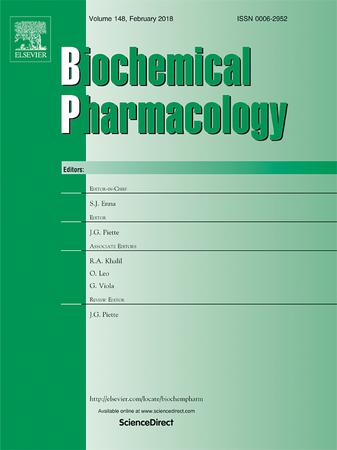GSNO诱导线粒体Cx43亚硝基化对体外小鼠胚胎干细胞心肌细胞分化的影响
IF 5.3
2区 医学
Q1 PHARMACOLOGY & PHARMACY
引用次数: 0
摘要
s -亚硝基谷胱甘肽(GSNO)被认为对蛋白质的s -亚硝基化至关重要,对心肌细胞(CMs)的成熟至关重要。我们之前的研究表明,在小鼠胚胎干细胞(ESCs)向CMs分化的过程中,GSNO处理显著增强了104个蛋白的s -亚硝基化。线粒体Cx43 (mtCx43)是一种参与细胞间通讯的膜蛋白,在干细胞的CMs再生中也起着关键作用。然而,mtCx43 s -亚硝基化在gsno诱导的心肌分化中的作用尚未完全阐明。在这项研究中,我们采用了escs衍生的CMs分化模型来阐明gsno诱导心脏发生的机制。研究结果表明,GSNO处理显著上调了胚状体(EBs)线粒体跨膜电位、ATP生成、活性氧(ROS)水平、呼吸链复合物Ι活性和mtCx43半通道通透性。此外,GSNO处理后,mtCx43的s -亚硝基化在EBs分化过程中显著增强。过表达mtCx43进一步放大了GSNO的促线粒体成熟作用,而过表达突变体mtCx43C271A则减弱了这种作用。为了研究mtCx43半通道的功能作用,我们用特异性mtCx43半通道阻滞剂Gap19预处理EBs,然后给药GSNO。Gap19显著降低mitofusin 2 (Mfn2)的表达,从而损害线粒体的成熟和功能。此外,Gap19处理消除了mtCx43 s -亚硝基化的促心作用。此外,我们证明了mtCx43 s -亚硝基化诱导的心脏分化依赖于线粒体Ca2+摄取。综上所述,gsno诱导的mtCx43 s -亚硝基化通过促进mtCx43半通道的开放来增强EBs的线粒体功能,从而促进ESCs向CMs的定向分化。这些发现为mtCx43 s -亚硝基化在线粒体调节和心脏谱系承诺中的作用提供了新的见解。本文章由计算机程序翻译,如有差异,请以英文原文为准。

GSNO induced mitochondrial Cx43 nitrosylation in cardiomyocyte differentiation from mouse ES cells in vitro
S-nitrosoglutathione (GSNO), considered vital to S-nitrosylation of proteins, has been found fundamentally important to the cardiomyocytes (CMs) maturation. Our previous studies demonstrated that GSNO treatment significantly enhanced the S-nitrosylation of 104 proteins during the differentiation of mouse embryonic stem cells (ESCs) into CMs. Mitochondrial Cx43 (mtCx43), a membrane protein implicated in the intercellular communication, also plays a pivotal role in CMs regeneration from stem cells. However, the involvement of mtCx43 S-nitrosylation in GSNO-induced myocardial differentiation has not been fully elucidated. In this study, we employed an ESCs-derived CMs differentiation model to elucidate the mechanisms underlying GSNO-induced cardiogenesis. Our findings revealed that GSNO treatment significantly up-regulated mitochondrial transmembrane potential, ATP production, reactive oxygen species (ROS) levels, respiratory chain complex Ι activity and mtCx43 hemichannel permeability in embryoid bodies (EBs). Furthermore, S-nitrosylation of mtCx43 was markedly enhanced in differentiating EBs after GSNO treatment. Overexpression of mtCx43 further amplified the pro-mitochondrial maturation effects of GSNO, whereas overexpression of a mutant form, mtCx43C271A attenuated this effect. To investigate the functional role of mtCx43 hemichannels, we pretreated EBs with Gap19, a specific mtCx43 hemichannel blocker, followed by GSNO administration. Gap19 significantly reduced in mitofusin 2 (Mfn2) expression, thereby impairing mitochondrial maturation and function. In addition, Gap19 treatment abrogated the pro-cardiogenic effects of mtCx43 S-nitrosylation. Furthermore, we demonstrated that mtCx43 S-nitrosylation-induced cardiac differentiation was dependent on mitochondrial Ca2+ uptake. In conclusion, GSNO-induced S-nitrosylation of mtCx43 enhances mitochondrial function in EBs by promoting the opening of mtCx43 hemichannels, thus facilitating the targeted differentiation of ESCs into CMs. These findings provide novel insights into the role of mtCx43 S-nitrosylation in mitochondrial regulation and cardiac lineage commitment.
求助全文
通过发布文献求助,成功后即可免费获取论文全文。
去求助
来源期刊

Biochemical pharmacology
医学-药学
CiteScore
10.30
自引率
1.70%
发文量
420
审稿时长
17 days
期刊介绍:
Biochemical Pharmacology publishes original research findings, Commentaries and review articles related to the elucidation of cellular and tissue function(s) at the biochemical and molecular levels, the modification of cellular phenotype(s) by genetic, transcriptional/translational or drug/compound-induced modifications, as well as the pharmacodynamics and pharmacokinetics of xenobiotics and drugs, the latter including both small molecules and biologics.
The journal''s target audience includes scientists engaged in the identification and study of the mechanisms of action of xenobiotics, biologics and drugs and in the drug discovery and development process.
All areas of cellular biology and cellular, tissue/organ and whole animal pharmacology fall within the scope of the journal. Drug classes covered include anti-infectives, anti-inflammatory agents, chemotherapeutics, cardiovascular, endocrinological, immunological, metabolic, neurological and psychiatric drugs, as well as research on drug metabolism and kinetics. While medicinal chemistry is a topic of complimentary interest, manuscripts in this area must contain sufficient biological data to characterize pharmacologically the compounds reported. Submissions describing work focused predominately on chemical synthesis and molecular modeling will not be considered for review.
While particular emphasis is placed on reporting the results of molecular and biochemical studies, research involving the use of tissue and animal models of human pathophysiology and toxicology is of interest to the extent that it helps define drug mechanisms of action, safety and efficacy.
 求助内容:
求助内容: 应助结果提醒方式:
应助结果提醒方式:


